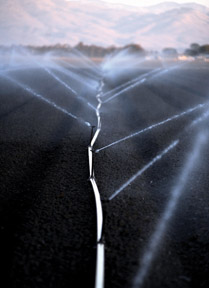In September 2014, Gov. Jerry Brown signed into law an unprecedented three-bill legislative package, known as the Sustainable Groundwater Management Act of 2014 (SGMA). The SGMA provides a framework for sustainable management of groundwater supplies by local authorities, with a limited role for state intervention only if necessary to protect the resource.
The act requires the formation of local groundwater sustainability agencies (GSAs) that must assess conditions in their local water basins and adopt locally-based management plans. The act provides substantial time—20 years—for GSAs to implement plans and achieve long-term groundwater sustainability. It protects existing surface water and groundwater rights and does not impact current drought response measures.
Water managers in San Benito County recognized the need to manage our groundwater basin back in the 1950s. A report was published by the Bureau of Reclamation entitled, “Hollister Reconnaissance Report of 1950”. This report confirmed that San Benito County could not develop enough local water to overcome the annual overdraft from pumping and water would have to be imported in the future. This report recommended consideration of bringing water from the Central Valley Project via the Pacheco Route into San Benito County.
The community started working to make this a reality. It wasn’t until the 1980’s that the vision exhibited in the 1950’s was realized in the San Felipe Project.
Regionally, low precipitation and snow melt in the Sierra Nevada’s reduced imported water supplies this past year. The agricultural allocation of water for the District was zero percent of its contract. Nonetheless, through transfers, exchanges and reservoir storage, the District was able to deliver over 7,000 acre-feet (AF) of water (one AF of water equals 325,851 gallons).
Due to limited imported water, water users relied on groundwater. Groundwater pumping saw a 30 percent increase from the previous 10-year average. Prolonged groundwater use has resulted in some areas in the groundwater basin to decline 10 to 20 feet, and a small section saw up to 60 feet of decline. However, much of the basin remains 100 feet above historic lows and groundwater storage appears to be available for prolonged use. If dry conditions persist, either the basin must be replenished with natural or imported water, or water demand must be decreased to prevent additional declines. In other words, our groundwater basin can recover from the declines, has adequate storage for the near future and is reacting as water managers had expected.
Although the district will have to revise some of its programs and procedures to conform to the SGMA, most of the pieces are already in place due to the district’s proactive approach to managing our local groundwater basin. Dr. Iris Priestaf, one of the principal authors of the Annual Groundwater Report for the district stated, “The Annual Groundwater Report and the District’s ongoing management activities are a strong foundation to fulfill the requirements of the recent state legislation, the Sustainable Groundwater Management Act”.
By contrast there are many areas of the San Joaquin Valley, and elsewhere, where groundwater levels are more than 100 feet below previous historical lows. This is the result of not managing these basins in an effective way during the current drought and through previous years of limited water and below average rainfall.
Each year a groundwater report is produced by the San Benito County Water District. This report describes groundwater conditions in the San Benito County portion of the Gilroy-Hollister groundwater basin. It documents water supply sources and use, groundwater levels and storage, and district management activities for the water year (Oct. 1–Sept. 30).
Recommendations are provided with regard to groundwater replenishment, groundwater pumping and the amount of water to import for the next water year.
Dr. Priestaf commented on the groundwater management activities performed by the District: “Through water importation (and other activities), the District reversed local groundwater overdraft and stored water in the groundwater basin to be a reserve during drought. This has helped avoid the problems of excessive groundwater level decline and subsidence that have afflicted other basins.”
This year’s report was of particular interest since we have been experiencing a statewide drought of historic proportions. Locally, rainfall was less than half of our average amount. An average year brings 11 inches to 13 inches of rain to San Benito County. This last year, rainfall amounts were 5.4 inches at the district’s weather station.
Groundwater reports have been utilized ever since the San Benito County Water District was founded. As Dr. Priestaf stated at this year’s annual groundwater meeting: “The District has been providing Annual Reports to the public since 1953—a long history of documenting local groundwater conditions. The District’s commitment to its Annual Groundwater Report is outstanding. The regular collection and analysis of information allows the District to be proactive in its management of water resources.”
Shawn Novack is water conservation program manager for the Water Resources Association of San Benito County.










